Mbuna

Mbuna (pronounced boo-nuh[1] ) is the common name for a large group of African haplochromine cichlids from Lake Malawi. The name mbuna means "rockfish" in the language of the Tonga people of Malawi.[2] As the name implies, most mbuna are cichlids that live among the piles of rocks and along the rocky shores of Lake Malawi, as opposed to the utaka and other "haps," cichlids that live in the open water or on sandy shores or soft substrates. Some species of Mbuna are highly sexually dimorphic, although many are not. Among biologists, it is believed that all of the cichlid species of Lake Malawi, including Mbuna and non-mbuna such as the Utaka, were descended from one or a very few species that became cut off from each other through periods of decreasing water levels that formed the three Great rift lakes into many smaller lakes. In isolation they adapted to their immediate surroundings. With time the waters again rose, and these new species were forced to adapt, once more, to new competition. The introduction of these, now highly specialized species to each other, created some very strange adaptations and unique behaviors making them some of the most unusual fresh water fish in the world. Their wonderful colors, intriguing behavioral characteristics and relative hardiness make them very popular despite their unique demands for the home aquarist.
Mbuna in aquaria

These cichlids are some of the most colorful freshwater fish for the home aquarium. Mbuna are very aggressive and territorial fish, they are not suitable for beginner fishkeepers. A suitable aquarium setting includes many rocks, adequate filtration, caves and hiding places; plants may be uprooted so they are best avoided but a small number will work well in the aquarium. One of these is Java fern, which may become the object of mbuna aggression but will not be eaten due to an undesirable taste.
Substrate
Sand or gravel is the ideal substrate. The hobbyist will want to mix in some sort of so-called "tufa rock" as a pH buffer. However, Limestone, Holey rock, aragonite, crushed coral and especially mixed bags of substrate do. Generally, tanks of no less than 120 centimetres (3.9 ft) in length is required for mature Mbuna; 110 litres (24 imp gal; 29 US gal) tanks will work beautifully for juvenile fish but will need to be upgraded as they mature, grow and become more aggressive and territorial (this will occur in just a matter of weeks or months). Ideally, no smaller than a fifty five gallon tank should be considered as adequate space for a colony of Mbuna. In the wild Mbuna are mostly omnivores; their diet consists of insect larvae and aufwuchs[3] and they generally benefit from a varied diet.
Decor
While like any aquarium, the African cichlid tank can be decorated to the aquarist's liking, Mbuna will far more enjoy a tank that is designed including numerous cave or hiding places. These caves are easily formed using rocks as would be found in the Mbuna's natural environment or the aquarist can use artificial means. Some popular options are inexpensive flower pots or prefabricated items from a local pet supply store. The flower pot method involves purchasing clay flower pots of a suitable size and chiseling out one side, such that the pot can be easily planted into the substrate to create a cave. It is recommended that the freshly broken edges be sanded down to avoid harming tank inhabitants, as Mbuna tend to be rowdy. Another less popular option, because of cost, is a three-dimensional background. These backgrounds can be extremely costly, although some aquarist construct backgrounds themselves.
Filtration
Because of Mbuna's ferocious digging habits and the recommended sand/crushed coral substrate under gravel filtration is not recommended. High volume hang over the back (H.O.B.), high capacity power filters or canister filters are recommended. For example, on a fifty-five gallon aquarium will be adequately filtered with the use of two four hundred gallon per hour(G.P.H.) In more advanced setups (75 gallons or more) a refugium maybe be a more effective method for filtration. These cichlids must be kept in well filtered, heavily stocked mbuna-specific aquariums. Small, high flow circulation impellers are utilized to circulate water through crevices and stir up detritus that maybe become deposited within the rock work and caves.
Social behavior
Mbuna exhibit strong social behavior and establish a clearly visible social hierarchy including well defined and enforced territories. A dominate male will maintain a spherical territory only allowing females to enter this territory for breeding purposes. Over-crowding helps spread out the aggression caused by these territorial conflicts. By over crowding, it is possible to break down these barriers and create an environment where no particular individual gets bullied to death. They, like the Astatotilapia burtoni, are maternal mouthbrooders and breed readily in good conditions. Most species thrive in colonies made up of 1M and 3-5F. This allows the gravid females to hide peacefully until gestation by dispersing the males advances throughout the harem.
Water parameters
All species from Lake Malawi thrive in the temperature range of 77-84°F. pH 7.5-8.4 is ideal with an almost pristine (near 0 ppm) Ammonia and Ammonium Nitrite content, Ammonium Nitrate levels are controlled by water changes as needed to maintain these demanding levels. Due to the high mineral content of Lake Malawi many Aquarists supplement their water with specific salts and mineral additives. The dissolved minerals are predominately sodium, calcium, magnesium and potassium. GH / KH A GH value over 10 is a good starting point (moderately hard water). KH values are not so crucial for the well being of the Malawi cichlid but it can help a lot to keep the pH stable even if something goes wrong (carbon dioxide injection or overfeeding). A KH value of 8-10 is a sure bet.
Notable mbuna cichlids
Many mbuna cichlids are regularly stocked and sold by pet shops. Some of the most common ones are the Bumblebee Cichlid or Hornet (Pseudotropheus crabro), Golden Cichlid (Melanochromis auratus), Electric Yellow or Yellow Lab cichlid (Labidochromis caeruleus), red zebra cichlid (Maylandia estherae), Blue Zebra (Maylandia callainos), and Melanochromis cyaneorhabdos (Blue Johannii) cichlid. Many of these species are considered to have large territorial needs and will aggressively defend these territories making them a handful for the ill-prepared novice hobbyist. Cichlids belonging to any of the genera listed below are considered mbuna.
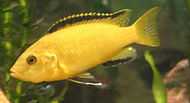
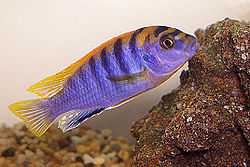
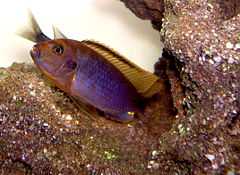
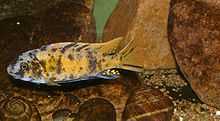
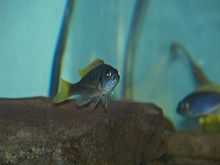
.jpg)
- Abactochromis Oliver & Arnegard 2010
- Cyathochromis Trewavas 1935
- Cynotilapia Regan 1922
- Genyochromis Trewavas 1935
- Gephyrochromis Boulenger 1901
- Iodotropheus Oliver & Loiselle 1972
- Labeotropheus Ahl 1926
- Labidochromis Trewavas 1935
- Maylandia Meyer & Foerster 1984. (syn. Metriaclima Stauffer, Bowers, Kellogg, & McKaye 1997 [4])
- Melanochromis Trewavas 1935
- Petrotilapia Trewavas 1935
- Pseudotropheus Regan 1922
- Tropheops Trewavas 1984
The list below includes groups of non-mbuna mouthbrooding cichlids from Lake Malawi.
- Peacock cichlids (Aulonocara species)
- Utaka cichlids
- other genera of "Haps" such as Rhamphochromis
References
- ↑ "Mbuna Cichlids". Aquatic Community. Retrieved 2 May 2014.
- ↑ Loiselle Paul V. (1988) A Fishkeepers Guide to African Cichlids. p 97. Salamander Books, London & New York, ISBN 0-86101-407-3.
- ↑ http://www.malawicichlids.com/mw01100.htm
- ↑ M. K. Oliver, Ph.D. (2002) Maylandia, Metriaclima or Pseudotropheus? from www.malawicichlids.com
- ↑ Info on keeping Malawi cichlids
- ↑ African Cichlid Genus Gallery
- ↑ Ad Konings biography
See also
- List of freshwater aquarium fish species
- Utaka
- South American Cichlids
- Cichlids
- Aquarium